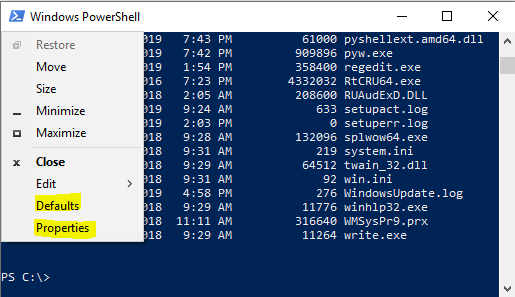Configuring settings
The settings of the console host are taken from various places:
- Hardcoded values in
ConhostV1.dll(orconhostv2.dll?) -
HKCU\Console - Subkeys of
HKCU\Console(where the key name is either the exe path of the console application (backslashes replace by underscores) or the application's title - Windows shortcut files (
*.lnk)
A list of settings that can be adjusted is here.
When an application is started through a
*.lnk file, the values in the subkey of HKCU\Console are irrelevant.
The menu of an application that uses
conhost.exe (such as PowerShell in the following picture) contains the two entries Defaults and Properties.
Choosing Defaults allows to change the settings that are stored in 
HKCU\Console while Properties allows to change the settings in either the subkey of that registry key or the *.lnk file. 